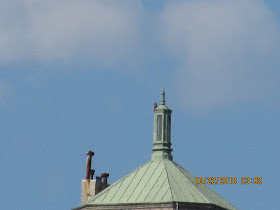
11/04/2006, Four years ago to the drizzling day a damp Pale Male, surveys his kingdom from the 927 Fifth Ave. nest.
So maybe he'll be doing it again tomorrow. Now wouldn't it be fun to live with Pale Male? Well not so much live on the nest exactly, but how about an apartment in 927?

If you happen to have a spare 26 million laying around, one of those sets of ringside windows can be yours.
(Boy would you have a lot of new friends who'd just die to come over for tea, or what?)
From Robin of Illinois from the NY Times Real Estate Section--
Wasserstein Estate Selling Co-op in Building Where Hawks Raised Hullabaloo
By SARAH KERSHAW
Published: October 29, 2010
The 12-unit co-op at 927 Fifth Avenue has been home in recent years to some rather famous people, including Mary Tyler Moore, the shoe designer Kenneth Cole and the CNN news anchor Paula Zahn. The list also includes celebrities of another species: two red-tailed hawks named Pale Male and Lola, whose nest on the 12th-floor cornice caused a hullabaloo on the co-op board, with city and federal officials stepping into the fray.
More: Click on the link
http://www.nytimes.com/2010/10/29/realestate/29wasserstein.html?src=twrhp

Yes, the gulls are obviously migrating through. Today as I drove down a country road, I looked over and, WOW, conceivably thousands of gulls were wheeling over a field and a thousand or more were just sitting around in the dirt.
What's going on?
I pull over, and scan the area.

Ah ha! There is a tractor that likely is disc-ing the field, doing a turn around with the discs lifted. Gulls obviously having the proceedings down. Discs up, no goodies.

Discs down and the feast continues. Some of the gulls may be either full, or doing sentinel duty as they just stand there as the tractor and the hordes pass by. See the single gull standing on the left behind the machinery?

She's still standing there.

She's turned but still there and looks to be getting company in the standing around section.

If you look further over in the field, you'll see a scattered group of gulls waiting for the next pass by the tractor. Perhaps the pickings are so good, one can take a little time to digest, before going for it once again.

Actually, I think there is a system to all the madness, as there was when the very large flock of gulls took turns foraging for earth worms in the park behind my house some years ago.
Look to to the far right of the photograph. Those birds aren't eating, they're just mostly standing around.
It appears that they are going in stages. As one group goes from the end of the line to the front, the tractor discs a new portion of ground as they arrive. Looks crazy but if you watch carefully, it is rather orderly about giving everyone a chance to eat.
Okay, now the tractor has turned and is heading toward the back of the line who are still standing around. But look, birds are coming from the right, flying over the tractor and taking on the new ground that's just been exposed. The others wait until they're the end of the line and can go forward and be the front of the line on the newly turned ground themselves.
What do you think?
Now we're getting to the end, of the end of the line, of this tractir pass with only a few birds waiting to make the cross.
There they go.
By the way, the farmer and the gulls are an example of a grand symbiotic relationship, i.e. both parties benefit from the other.
Farmers these days, try to avoid disturbing the soil anymore than they have too. Turning over the dirt brings all sorts of pesky weed seeds to the surface as well as all sorts of insects. But our buddies the gulls, being omnivores, just gobble up whatever is turned up. Plus depositing some of the best fertilizer known to man into the soil.
Speaking of avian droppings, many a church in the middle ages kept pigeons not only for pigeon pie, roasted squab, and omelets but for their extremely valuable droppings. The droppings were collected and were so precious that in some areas, it was one of the few ways that a hard money poor church, could buy those extras only to be had by spending coin.
Just think of all that city pigeon created fertilizer (and ready cash) going to waste, because it isn't collected. It's an invisible ready made cash crop.
Donegal Browne






















.jpg)




